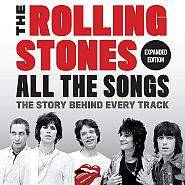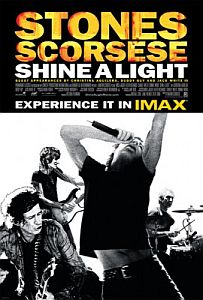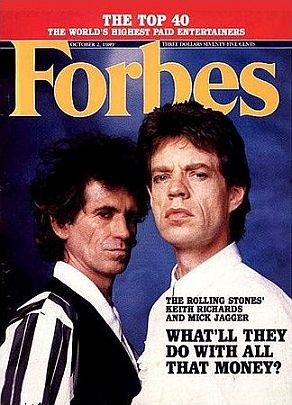
October 1989 edition of Forbes business magazine featuring Mick Jagger & Keith Richards among the world's 'highest paid entertainers'.
In the feature story, Forbes writer Peter Newcomb provided a detailed look at what the Stones were then up to, and by way of their experience, a revealing look at the rock ‘n roll business on its way to the 1990s.
The Stones, even then, were a “senior” rock ‘n roll group, having risen to fame, along with the Beatles, a good 25 years earlier in the 1960s. Yet at this point in their lives and careers, they still had another 20 years of performing ahead. But in the late 1980s when Forbes caught up with them, they were at the beginning of a series of live concerts called the “Steel Wheels Tour,” a tour launched to coincide with a new album, also titled Steel Wheels. This tour, however, also presaged a new era in the business of rock ‘n roll, and specifically the big business of concert touring.
In 1988, a Canadian promoter named Michael Cohl had guaranteed the Stones a take of $70 million for the tour. The math went something like this: the tour would draw 3 million people in just under 60 locations. At about $30 a ticket, a $90 million gate would be generated, with 40 percent paid to the stadium owners and local promoters, leaving 60 percent — or more than $50 million — to the Stones and the tour promoter. Tour-related merchandise, including T-shirts, jackets, and other paraphernalia, would boost the take to the guaranteed $70 million. In fact this tour, and its related business, would generate considerably more than $70 million.
Macy’s, Bud & Beyond
The Stones had also made arrangements to sell tour-related material not only at the concert sites, but also at department stores such as Macy’s, J. C. Penney, and Marshall Field. In some of these stores, “Rolling Stones boutiques” offered a full line of products stamped with the Steel Wheels logo: $5 bandanas, sweatshirts, skateboards, $450 bomber jackets, and two lines of Converse high-top sneakers. There were also pay-per-view TV rights in the offing at $6-to-$7 million, not including foreign TV rights. A tour-related movie and a two-hour TV special were being planned as well. “We never dreamed there was any money when we started this thing. It was idealism. It was not knowing what else to do with your life. But then, suddenly, the impossible happened.”
– Keith Richards, 1989 And finally, Anheuser-Busch paid close to $6 million for rights to make its Budweiser beer the tour sponsor. All of this meant that the Stones would gross about $90 million for the year.
By the time of their 1989 concert tour, however, the Stones were already a group with a significant cache of assets. They also had a musical legacy — a “bank account” of sorts — to draw upon even in off years when there was no tour income or no new album. Between 1964 and 1979, the Stones had turned out at least one album every year; sometimes 2 or 3 albums per year in that period. Many of these albums charted in the U.S and the U.K., often in the Top 10 or Top 20. So by 1989, this catalog of older Stones recording was still selling, and selling well, at about 1 million copies a year. With a royalty rates then about $1.75 per record, they would have about $2 million a year coming in just from that catalog, making a kind of annuity possible even if they quit work. But if they chose on top of that to do a single new album which sold at around 3 million copies, the annual take would rise to as much as $7 million a year. There was also income from radio airplay as well. And as songwriters the Stones had agreements for a royalty of about 5 cents per airplay, which can also add up to real money with popular hits — or as Keith Richards once put it, “making money while I sleep.”
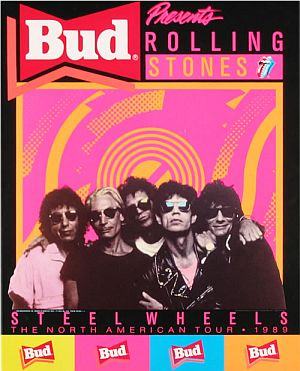
Budweiser was a Steel Wheels sponsor.
Business Savvy
At the time of the Steel Wheels Tour in 1989, the Rolling Stones were already pretty savvy business people. Since 1971, they had secured the services of a former London merchant banker named Rupert Zu Loewenstein, who carries an old Bavarian title of “Prince” and became their financial advisor. The Stones by then were also pretty capable when negotiating recording deals. In 1985 they signed a distribution agreement with CBS Records that reportedly gave the band $25 million for four albums and the rights to all the old Rolling Stones catalog from Atlantic. Walter Yetnikoff, the CBS record chief who negotiated with Jagger, said that “Mick was very astute,” lauding him as a guy who could think on his feet, capable of figuring royalty and tax rates in his head. Jagger had studied macroeconomics at the London School of Economics, which he would later say was mostly economic history.
But the Stones weren’t always on top of their game economically. In fact, in the early years, they lost a good deal of money making bad deals. During the mid-1960s, when the Stones first broke out, they had sold some ten million singles, including their monster 1965-66 hit “Satisfaction.” They also sold some five million albums in the early years. Still, they were not making money.“When we first started out, there wasn’t really any money in rock ‘n roll. There wasn’t a touring industry; it didn’t even exist….”
– Mick Jagger “When we first started out, there wasn’t really any money in rock ‘n roll,” Jagger explained to Fortune magazine in 2002. “There wasn’t a touring industry; it didn’t even exist. Obviously there was somebody maybe who made money, but it certainly wasn’t the act. …[E]ven if you were very successful, you got paid nothing.” The Stones also suffered from lack of negotiating experience. “I’ll never forget the deals I did in the ’60s, which were just terrible,” Jagger would later say. In 1965, Allen Klein, a New York manager, helped the Stone’s negotiate a new contract with Decca records and also helped the group win their first million-dollar payday. But Allen Klein also helped himself. His company, ABKCO, still retains the rights to the Stones’ early songs from the 1960s through 1971 — a sore point with the Stones, who parted ways with Klein in the early 1970s. Since then, the Stones have been very much a business-minded rock ‘n roll group, attentive to everything from royalty rates to tax policy. But by the time of their 1989 Steel Wheels tour, their business savvy had reached a new level and demand for their music was as strong as ever.
Steel Wheels Success
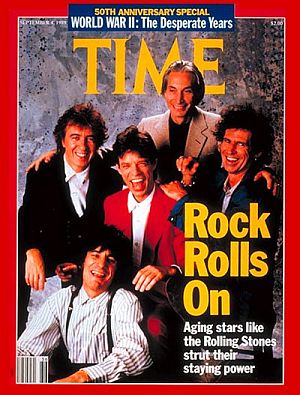
Just as the Rolling Stones were beginning their North America 'Steel Wheels' tour in 1989, they appeared on the cover of Time magazine, September 4th, 1989. Click for copy.
Tour Model Honed
Yet 1989’s Steel Wheels was just the beginning for the Rolling Stones. More gate-busting tours would follow over the next two decades. But Steel Wheels became the model. Its promoter, Canadian Michael Cohl, was hired permanently by the Stones to become their full-time tour manager. With each subsequent tour, the 1989 experience was honed, costs were pared, and even bigger paydays resulted.
|
The Rolling Stones Steel Wheels |
The Stones’ Voodoo Lounge tour of 1994-95 grossed nearly $370 million worldwide. In 1997-1999, the Bridges to Babylon/No Security Tour grossed more than $390 million, attracting some 5.6 million people worldwide. By 2002, Fortune magazine estimated that between 1989 and 2002, the Stones pulled in about $1.5 billion, including tours and other business, an amount that exceeded what other rock ‘n roll competitors did in that same period, whether U-2, Michael Jackson, Britney Spears, or Bruce Springsteen. Nor did the Rolling Stones’ touring end in 2002. Their Forty Licks world tour of 2002-2003 played to an audience of 1 million, generating $200 million over 32 show dates in the U.S., Canada, Europe, and the Far East. In 2005, they released a studio album, A Bigger Bang, followed by another tour — this one the highest-grossing tour in history, pulling in $558 million between the fall 2005 and late August 2007, according to Billboard.
The Stone’s success with touring and their tour-related businesses no doubt had an impact on other “retired” rockers who in recent years decided to get back in the game and on the road again. But other economic factors were also at work by the late 1990s. The traditional music sales model was changing dramatically with the internet and MP3 players, as album and CD sales began to plummet. The live-performance business became a much more important source of income for artists, old and new. Still, the Stones appear to have made a special category all their own.
Fortune magazine’s Andy Serwer, writing in September 2002 on why the Stone’s continued their appeal way beyond their prime hit-producing years, explained:
“…Subjectively, the Rolling Stones sound pretty damn good, even after all these years. And objectively, if they’re such has-beens, then how do you explain the band’s phenomenal commercial success over the past decade? No, they aren’t writing groundbreaking songs anymore — in fact they haven’t really recorded any new material of note in 20 years — but we sure are listening to their old stuff. A lot. And buying concert tickets. Millions and millions of them. And that’s the wrinkle here. Even though the Stones have been in what you might call a creatively fallow period, we want to hear them more than ever. Couple that with the fact that they have perfected their business model, and it’s easy to understand why they are such an astounding money-making machine.”
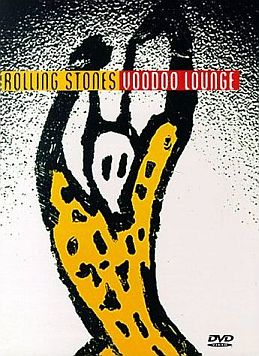
Although not turning out hits at the rate they did in the 1960s & ‘70s, the Rolling Stones in the 1990s & 2000s used concert filming & DVDs to package their music in a new way as in 1995's Voodoo Lounge DVD.
Songwriting, Ads & Film
Beyond touring and DVDs, there have also been other business deals and income streams to help fill the Stones’ coffers. Songwriting royalties continue to flow to Jagger and Richards for the 200 or so songs they have jointly written. “Music publishing is more profitable to the artist than recording,” Jagger explained to Fortune magazine in 2002. “It’s just tradition. There’s no rhyme or reason. The people who wrote songs were probably better businesspeople than the people who sang them were. You go back to George Gershwin and his contemporaries — they probably negotiated better deals, and they became the norm of the business. So if you wrote a song, you got half of it, and the other half went to your publisher. That’s the model for writing.” So anytime one of the Jagger/Richards songs is played on the radio or any other public venue, they get a piece of the action.
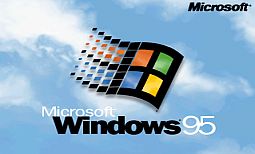
In 1995, Bill Gates made a multi-million-dollar deal to use the Rolling Stones’ 1981 song ‘Start Me Up’ as the theme song in an advertising campaign to launch & sell Microsoft’s new computer software.
Ray Gmeiner, a vice president at Virgin Records has stated that “The Rolling Stones are a unique brand because they’ve taken the business side of rock and roll to the level that few if any other bands have.” Add Roger Blackwell and Tina Stephan in their 2004 book, Brands That Rock: “The Rolling Stones organization is a well-oiled, money making machine, and to say it resembles anything less than a Fortune 500 firm would be unjust…”
Still Rocking
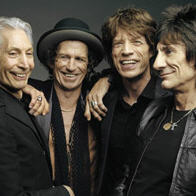
The Rolling Stones, 2005.
Their business empire aside, however, at the center of the Rolling Stones is their music. Millions of fans young and old still enjoy that music, and will no doubt continue to enjoy it for many years into the future. And for the Stones too, the music is key. They don’t really need to be touring; they make money standing still. In a 1995 interview with Jan Wenner of Rolling Stone magazine, Jagger told Wenner that love of the blues, love of rock music, and love of performing that music was at the center of what he did. And Keith Richards has said much the same. “This whole thing runs on passion,” Richards told Fortune in 2002. “Even though we don’t talk about it much ourselves, it’s almost a sort of quest or mission.” New York Times reporter Stephen Holden recently wrote in an April 2008 review of Martin Scorcese’s documentary featuring Stone’s concerts, “…[T]he Rolling Stones appear supremely alive inside their giant, self-created rock ‘n roll machine. The sheer pleasure of making music that keens and growls like a pack of ravenous alley cats is obviously what keeps them going. Why should they ever stop?”
Other stories on the Rolling Stones at this website include: “Paint It Black” (song history & subsequent uses); “Start Me Up” (use of song by Microsoft as Windows 95 theme song), “…No Satisfaction”(1966 song that marked a kind of cultural divide at the time); and, “Shine A Light” (Martin Scorsese / Rolling Stones film trailer). Additional stories on music history, song profiles, and artist biography can be found at the “Annals of Music” category page. Thanks for visiting – and if you like what you find here, please make a donation to help support the research and writing at this website. Thank you. – Jack Doyle
|
Please Support Thank You |
____________________________
Date Posted: 3 December 2008
Last Update: 9 July 2017
Comments to: jdoyle@pophistorydig.com
Article Citation:
Jack Doyle, “Stones Gather Dollars, 1989-2008,”
PopHistoryDig.com, December 3, 2008.
_____________________________
Rolling Stones at Amazon.com…
Sources, Links & Additional Information
Jay Cocks, “Roll Them Bones,” Time, Monday, September 4, 1989.Peter Newcomb, “Satisfaction Guaranteed,” Forbes, October 2, 1989.
Constance L. Hays, “2 Generations of Fans Enjoy Rolling Stones’ Live Legacy,” New York Times, October 11, 1989.
Tom Harrison – Music Critic, “Keith Richards Sets The Tone,” The Vancouver Province, November 1, 1989.
Michiko Kakutani, Pop View, “Troubadours Of Fickle Time And Its Passing,” New York Times, September 4, 1994.
Richard Harrington, “That Old Jagger Edge; At RFK, the Stones Rock and Roll On,” Washington Post, August 2, 1994, p. F-1.
“Microsoft Throws Stones Into Its Windows 95 Ads,” New York Times, August 18, 1995.
David Segal, “With Windows 95’s Debut, Microsoft Scales Heights of Hype,”Washington Post, Thursday, August 24, 1995, p. A-14.
Jann Wenner, “Jagger Remembers: The Rolling Stone Interview,” Rolling Stone, December 14, 1995.
Michiko Kakutani, “Heart of Stones,” New York Times Magazine, October 12, 1997.
Richard Harrington, “Smooth Stones Roll Out The Oldies,” Washington Post, October 24, 1997, p. D-1.
Kelefa Sanneh, “Rolling Stones Revel in the Act of Survival,” New York Times, September 27, 2002.
Andy Serwer and associates Julia Boorstin and Ann Harrington, “Inside the Rolling Stones Inc.,” Fortune, September 30, 2002.
“A Conversation With Mick Jagger,” The Charlie Rose Show, Thursday, November 14, 2002
Roger Blackwell and Tina Stephan, Brands That Rock, Hoboken, NJ: John Wiley & Sons, 2004.
Jon Pareles, “Swaggering Past 60, Unrepentant,” New York Times, August 23, 2005.
J. Freedom du Lac, “Time on Their Side; The Rolling Stones, Still Rocking Like It’s 1995, or 1965,” Washington Post, October 4, 2005, p. C-1.
The Rolling Stones, No. 4, “The Forbes Celebrity 100,” Forbes, June 14, 2007.
Stephen Holden, “Only Rock ‘N’ Roll, but They’re Still at It,” New York Times, April 4, 2008.
“The Rolling Stones” and “Shine a Light,” Wikipedia.org, 2008.
_______________________________________________________
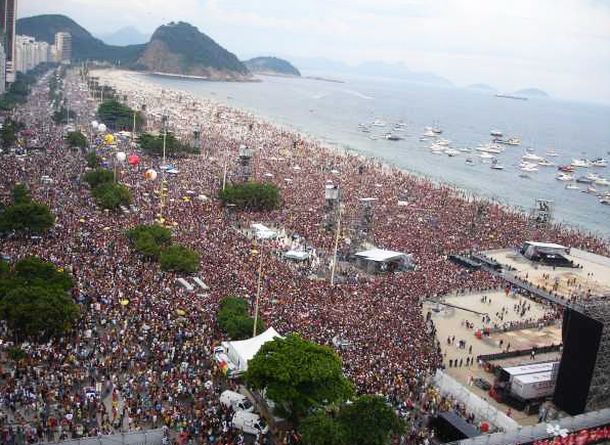
Seaside streets & Copacabana Beach in Rio de Janeiro, Brazil, 'filling up' with hundreds of thousands of onlookers & fans during the evening prior to Rolling Stones’ concert, February 2006.
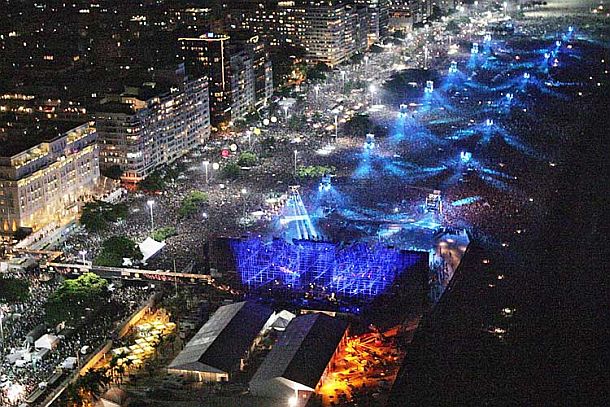
Later that night -- February 18th, 2006 -- at the same venue on Copacabana Beach as Stones played to a ‘full house’ estimated at 1.5 million.

